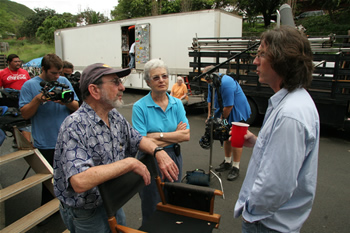Journeys Below the Line
A video series that
will help introduce film students to different areas of film production
October 3, 2006
Imagine spending time in Hawaii with the crew of the TV series “Lost.” Or
shooting footage during a filming of “ER” … or “24.”
During the
past few years, Lynne Gross, professor of radio-TV-film, has spent a
great deal of time behind the scenes … most recently working on educational videos
that demonstrate some of the “behind the scenes” work that
occurs during the production of prime-time television programs.
|
“Areas
such as cinematography, editing and prop making are considered ‘below the
line’ jobs in film and television,” Gross explained. “They
are critical to the success of a film, yet you often don’t realize
what time and talents are involved in each of these creative areas.”
Gross, with
several partners from the Academy of Television Arts and Sciences, is
involved in producing a video series called “Journeys Below the Line” that
will help introduce film students to different areas of film production.
“Students
often sign up for film classes because they want to write, act, produce or direct,” Gross
said. “There’s certainly nothing wrong with that but there
are lots of other jobs to consider as well. These videos can show students
some new career opportunities or help explain the importance of these
different fields.”
|
While taping “Lost,” the
crew focused on the job of the cinematographer.
“Essentially,
we were filming the filmers,” Gross said. “We conducted interviews
with them and also showed the types of work they do. I was quite impressed with
the way they were able to handle heavy camera equipment in the jungle. When you
see one of the actors running through the jungle, just remember this — there
is a film crew running in front of them. And they’re running backwards
and shooting footage at the same time. It gives you a whole new appreciation
for the work they do.”
|
For their
video on the Fox television series “24,” the focus was on editors.
The scene that Gross and her colleagues shot had FBI agent Jack Bauer
(played by actor Kiefer Sutherland) running through a subway station.
“The
script supervisor was there the whole time taking notes on everything to ensure
that the continuity of the footage was accurate,” she said. “They’d
even note such things as whether or not certain characters were wearing
rings during different scenes. Then, when the footage is being edited,
editors would refer back to those notes to make sure the scene ran smoothly
even though it may have been filmed in different sequences or parts
of the scene were filmed at different times.”
A scene where
a balcony collapses in “ER” was a nail-biting experience.
For a program
on property masters, Gross and her partners covered the prop makers
as they prepared for the balcony collapse scene — a story line that would continue to the
resulting scenes of many people being sent to “ER.”
“Of
course, they had to get the shot in one take — nothing could go wrong,” she
said. “I was impressed with the number of times they rehearsed everything
to ensure that the filming would go smoothly.
“They
needed and ensured that nobody would be hurt during the filming. All the props
had to be soft so if they hit somebody, they wouldn’t really hurt them,” Gross
noted. “There were 19 stunt people. In total, more than 300 people
were involved in that shoot.”
Gross also
was impressed with the program’s sound stage. “It really does look
like a hospital,” she said. “Obviously, there are lots of props
needed on a medical show.”
|
The episodes
covering the editing process on “24” and prop masters on “ER” are
currently available through First Light Video Publishing. The program
about the cinematography team of “Lost” is in post production.
“I enjoy
seeing the students’ reactions to the series,” she said. “I
think it really opens their eyes to the many possibilities in filmmaking … and
focusing on popular television shows doesn’t hurt either.”






 Produced by the Office of Public Affairs at California State University, Fullerton.
Produced by the Office of Public Affairs at California State University, Fullerton.